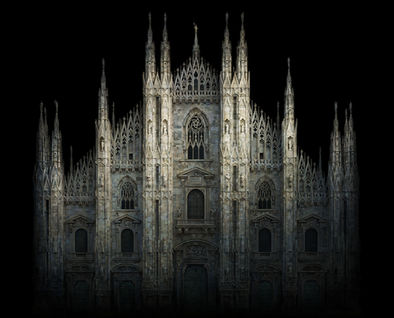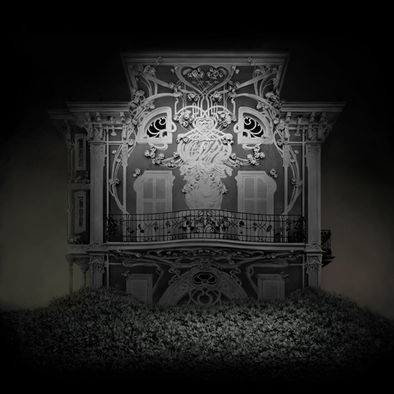FOTOTECA SIRACUSANA
PHOTOGALLERY - FOTOGRAFIA VINTAGE - BIBLIOTECA TEMATICA - CAMERA OSCURA B&W - DIDATTICA
SCRIPTPHOTOGRAPHY
Irene KUNG (IT)

IRENE KUNG
Città restituite in forma di sogno, ovvero come le abbiamo abitate nella nostra immaginazione notturna ed edifici che perdute le connotazioni architettoniche assumono un’identità trasognata, forse, chissà, la più vicina alle intenzioni di chi li ha costruiti. Benvenuti nelle “città oniriche” nelle quali Irene Kung ci invita a risiedere, a condizione che si chiudano gli occhi e si guardi con la mente.
Buio. Non mistero. Un buio che dialoga con la luce in una disciplinata alternanza di competenze, quasi una ritualità dove non c’è subordine e dal cui accordo fuoriescono monumenti come non li abbiamo mai visti prima: trasognanti, drammatici eppure leggeri, definiti eppure liberi dalla persistente sensazione del “già visto”. Le città di Irene Kung sono nuove come un viaggio appena compiuto, sorprendenti come un regalo inatteso e irreali come Atlantide o Metropolis. L’atmosfera che vi si respira ha molte eco, basta prestare ascolto e si odono echi di civiltà lontane, sepolte ma a noi vicinissime e restituite nella solitudine di una visione che richiama al raccoglimento. Siamo di fronte a una specie di “spoliazione”, al tentativo di ridare ai palazzi, ai monumenti la dignità perduta dall’accrescere prepotente di un tessuto urbano che risponde malamente alle sue stesse esigenze. Ecco dunque che le immagini si ritagliano, si stagliano nel buio fondale di un’astrazione che non ha nulla di distopico e in cui l’ammirazione cresce per ognuno dei dettagli che il giorno non ci consente di godere. “Di notte la città” ha scritto De Luca “è un paese civile”, perché risponde meglio del giorno alle nostre immaginazioni e dunque, in questa pacificazione, nelle fotografie di Irene Kung possiamo vedere quanto abbiamo amato in altri ambiti e desiderato nel reale, sicché il Chrysler Building e l’Empire State sembrano appena usciti da una scenografia per Fritz Lang; la Tour Eiffel ai più romantici apparirà una solida scala metallica con cui raggiungere una Luna uscita dai versi di Prévert; la moschea di Mohammed Ali una minacciosa base missilistica per gli amanti del genere; la Scala di Milano un rigorosissimo manuale per architetti in cerca di ordine alle idee. Tutto non è come appare.
La concretezza è liberata dai vincoli costruttivi e affidata alla geometria delle sensazioni e queste si stagliano in un’oscurità che non ha alcunché di minaccioso. Siamo dentro a un sogno e dunque il buio non deve spaventare, un sogno nel quale ogni visione è realizzata e la città vivente intende dare asilo alle nostre proiezioni. A condizione che si viaggi di notte.
Come nei sogni, appunto.
Giuseppe Cicozzetti
da “Invisible Cities”
foto Irene Kung
Cities returned in the form of dreams, or how we have inhabited them in our nocturnal imagination and buildings that have lost their architectural connotations assume a dreamy identity, perhaps, who knows, the closest to the intentions of those who built them.
Welcome to the "dream cities" in which Irene Kung invites us to reside, provided they close their eyes and look with their minds.
Dark. Not mystery. A darkness that communicates with light in a disciplined alternation of skills, almost a ritual where there is no suborder and from whose agreement come out monuments like we have never seen before: transgressing, dramatic yet light, defined yet free from the lingering sensation of "already seen".
The cities of Irene Kung are new as a journey just made, surprising as an unexpected and unreal gift like Atlantis or Metropolis. The atmosphere that you breathe has many echoes, just listen and we hear echoes of distant civilizations, buried but close to us and returned in the solitude of a vision that recalls to a concentration.
We are facing a kind of "spoliation", in an attempt to give back to palaces and monuments the dignity lost by the overbearing growth of an urban fabric that badly responds to its own needs.
Here then the images are cut out, stand out in the dark background of an abstraction that has nothing dystopian and where admiration grows for each of the details that the day does not allow us to enjoy.
"At night the city" wrote De Luca "is a civilized country", because it responds better to our imaginations of the day and therefore, in this pacification, in the photographs of Irene Kung we can see how much we have loved in other areas and desired in reality, so that the Chrysler Building and the Empire State seem to have just come out of a set for Fritz Lang; the Eiffel Tower to the most romantic will appear a solid metallic ladder with which to reach a moon out of the verses of Prévert; Mohammed Ali mosque a menacing missile base for lovers of the genre; La Scala of Milan a very rigorous manual for architects looking for ideas. Everything is not as it appears.
The concreteness is freed from constructive constraints and entrusted to the geometry of sensations and these stand out in a darkness that has nothing threatening. We are inside a dream and therefore the darkness should not scare, a dream in which every vision is realized and the living city intends to give shelter to our projections. Provided that you travel at night. As in dreams, precisely.
Giuseppe Cicozzetti
from “Invisible Cities”
ph. Irene Kung











